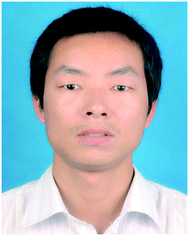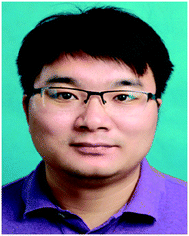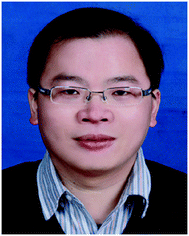Two-dimensional transition metal diseleniums for energy storage application: a review of recent developments
Yong-Ping
Gao
a,
Xu
Wu
c,
Ke-Jing
Huang
 *b,
Ling-Li
Xing
b,
Ying-Ying
Zhang
a and
Lu
Liu
a
*b,
Ling-Li
Xing
b,
Ying-Ying
Zhang
a and
Lu
Liu
a
aCollege of Science and Technology, Xinyang University, Xinyang 464000, China
bCollege of Chemistry and Chemical Engineering, Xinyang Normal University, Xinyang 464000, China. E-mail: kejinghuang@163.com; Tel: +86 376 6390611
cCollege of Physics and Electronic Engineering, Xinyang Normal University, Xinyang 464000, China
First published on 12th December 2016
Abstract
Two-dimensional transition metal diseleniums (2D-TMDSs) have recently triggered worldwide research interest due to their outstanding properties, such as abundance, low cost, chemical and thermal stability, low framework density and ease of processability. More fascinating is the fact that these materials are extensively used in energy storage (including supercapacitors, lithium ion batteries (LIBs), and sodium ion batteries (SIBs)) and hydrogen storage, and exciting progress has been recently achieved in the synthesis, characterization, device fabrication and functionalization of these 2D-TMDS materials. In this work, the properties of 2D-TMDSs and their use in energy storage are reviewed. In addition, being semiconductors with considerable mobility, TMDSs have been touted as a candidate in next generation electronics, and this review demonstrates the merits of TMDSs by intensive investigations into their use in energy storage. As a result of numerous opportunities for applications and multiple challenges to overcome, this review will be instructive and useful to researchers working in the area of 2D materials as well as scientists and engineers interested in their applications in supercapacitors, LIBs, SIBs and hydrogen storage.
 Ying-Ying Zhang | Ying-Ying Zhang is a student of chemistry in Xinyang College. Her research focuses mainly on micro/nanostructured materials for supercapacitor applications. |
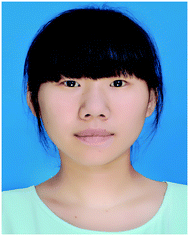 Lu Liu | Lu Liu is a student of chemistry in Xinyang College. Her research focuses mainly on micro/nanostructured materials for supercapacitor applications. |
1. Introduction
Meeting the growing energy demand of the current society, while avoiding resource depletion and environmental pollution, requires the development of high-performance, low-cost and environment-friendly energy storage and production systems.1–3 Currently, much research effort is focused on the improvement of the performance of energy storage devices, such as supercapacitors, batteries (especially LIBs and SIBs), and hydrogen storage. In order to accomplish such targets, key aspects are focused on the design of novel materials and the development of synthesis processes that allow precise control over the structural and chemical characteristics of the material, as well as seeking greener and more effective material synthesis processes for the widespread utilization of such devices.Recently, transition metal dichalcogenides (TMDCs) have been intensively investigated in energy storage fields because of their high theoretical capacity and inexpensiveness together with the abundance of the elements. TMDCs are layered materials consisting of a hexagonal arrangement of transition metal atoms sandwiched between two layers of group six chalcogenide atoms such as S or Se.4,5 The positions of the elements in the periodic table are highlighted in Fig. 1a.4 In TMDCs, the transition metal atoms are covalently bonded to a trigonal arrangement of chalcogenides within the same layer while individual layers are held together through non-covalent van der Waals forces. Fig. 1d describes the physical structure for a particular TMDC, MoS2.6 Unlike graphene which only has a single molecular structure as it contains only a single element and is a single atom thick, a single layer of TMDC which consists of three layers of atoms (a central transition metal sandwiched between chalcogenides) can exist in two different molecular structures, depending on the relative arrangement of the three atomic layers. Fig. 1b and c describe two molecular structures that a monolayer of TMDC can be in. The trigonal prismatic (D3h) phase has a non-centrosymmetric configuration while the octahedral (Oh) phase, also known as the antiprismatic point group (D3d) phase, has a centrosymmetric configuration.7
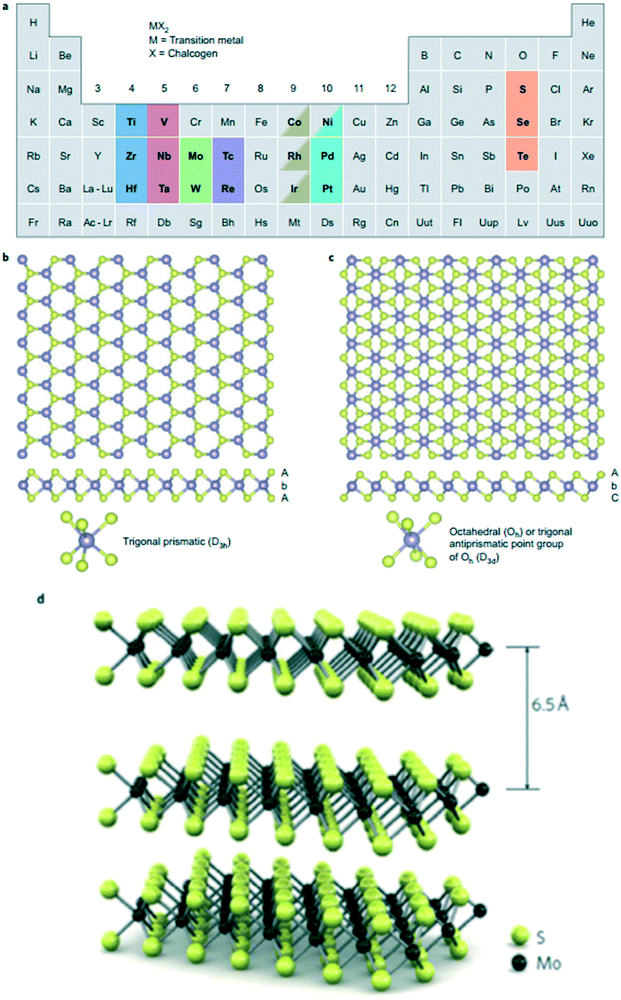 | ||
| Fig. 1 Structure of monolayer TMDCs. (a) About 40 different layered TMDC compounds exist. The transition metals and the three chalcogen elements that predominantly crystallize in these layered structures are highlighted in the periodic table. Partial highlights for Co, Rh, Ir and Ni indicate that only some of the dichalcogenides form layered structures. c-Axis and section view of single-layer TMDC with trigonal prismatic (b) and octahedral (c) coordination. Atom colour code: purple, metal; yellow, chalcogen. The labels AbA and AbC represent the stacking sequence where the upper- and lower-case letters represent chalcogen and metal elements, respectively. (d) Three dimensional representation of the structure of MoS2 with single layers being 6.5 Å thick. (a–c) Reproduced with permission.4 Copyright 2013, Macmillan Publishers Limited. (d) Reproduced with permission.6 Copyright 2011, Macmillan Publishers Limited. Reproduced with permission.38 Copyright 2010, American Chemical Society. | ||
Many reports, for instance, have described the energy storage of molybdenum disulfides by manufacturing MoS2 with particular morphologies and sizes8–12 and MoS2 with the combination of other electrically conductive matrixes13–19 including carbon nanotubes, graphene, carbon spheres, and polymers. As a matter of fact, selenium is a d-electron containing member of group 16 with high electrical conductivity (approximately 20 orders of magnitude greater than that of3 sulphur). However, the electrochemistry of Se in different electrochemical systems is still not fully understood, which may be the greatest hindrance for developing advanced Se electrode materials, and thus requires continuous investigation. In addition to the electrochemistry, for possible future applications, we have to evaluate several other benchmarks of Se in energy storage applications, which are listed in Table 1 in comparison with S. The density and electronic conductivity of Se are its advantages, while other characteristics raise some concerns (and some unnecessary concerns) about the application prospect of Se-based energy storage materials. On the contrary, Se-based materials have been explored as electrode materials for solar cells20–22 and rechargeable batteries.23,24 Two-dimensional transition metal diseleniums (2D-TMDSs), like 2D-TMDCs, are layered materials which can be thinned down to a single layer, albeit being three atoms thick instead of one.4 2D-TMDSs have exhibited considerable charge mobility with a semiconducting band gap,6,7,25 allowing significant intrinsic on–off current ratios.25 Furthermore, 2D-TMDSs have also shown remarkable physical and optoelectronic properties such as high tensile strength15 as well as exhibited intrinsic spin–valley polarization of its electronic bands.25 Thus, 2D-TMDSs have been touted to be a promising component in advanced device technology and optoelectronics. 2D-TMDSs are also focused on the improvement of performance of energy storage devices.
| Sulfur | Selenium | |
|---|---|---|
| Density (g cm−3)27 | 2.07 (α-S) | 4.8 (t-Se) |
| Electrical resistivity (μΩ cm)28 | 2 × 1023 (20 °C) | 1.2 (0 °C) the text runs thus |
| World production (2012, t)29 | 68![[thin space (1/6-em)]](https://www.rsc.org/images/entities/char_2009.gif) 100 100![[thin space (1/6-em)]](https://www.rsc.org/images/entities/char_2009.gif) 000 000 |
2240 |
| Toxicity (LD50 oral, rat, g kg−1)30 | 3 | 6.7 |
| Melting point (°C)30 | 114 | 217–222 |
| Autoignition temperature (°C)30 | 235 | n/a |
| Price (2013, $ per kg)31 | 0.124 (mine and/or plant) | 77 (refined) |
A multitude of articles have focused on the synthesis and applications of 2D-TMDSs, which mainly include top-down and bottom-up means. In top-down processes, they can be fabricated by thinning down bulk TMDS crystals to their constituent layers. The most commonly used method is mechanical exfoliation where an adhesive tape is used to peel off thin layers of TMDSs and deposit them on the desired surface.32 The crystal quality of the material produced as such is the highest but is greatly limited by the randomness in thicknesses of the flakes that can be obtained as well as its low yield which prevents potential from scaling up. Chemical vapor deposition (CVD) is an important bottom-up technique for growth of 2D-TMDSs, in which solid powders containing the elements present in the TMDS are thermally evaporated and undergo chemical reaction on a solid surface to form the desired TMDS layer in a furnace at high temperatures.33–35
2D-TMDSs have attracted crucial interest in multiple energy-related applications due to their processability and the possibility of tuning their textural and structural characteristics to fulfill the requirements of specific applications. Thus, they have an enormous attractiveness to the researchers as outstanding energy storage materials which may take the place of TMDC materials. Huang et al.36 first reported a simple hydrothermal method to synthesize layered MoSe2 nanosheets on Ni-foam (MoSe2–Ni) for enhanced supercapacitor performance. The MoSe2–Ni displayed faradaic pseudo-capacitance characterization and sufficiently favorable structure stability for sustaining good cycling stability (retaining 104.7% after 1500 cycles) as well as remarkably enhanced specific capacitance (1114.1 F g−1 at 1 A g−1). Wang et al.37 successfully synthesized VSe2/graphene nanocomposites as anode materials for lithium-ion batteries. Keith Share et al.38 primarily demonstrated tungsten diselenide (WSe2) as an efficient electrode for sodium ion batteries. A high reversible capacity above 200 s−1 was observed at 20 mA g−1 rate, with over 250 mA h g−1 capacity measured in the first sodium extractions. Ultra-thin and porous MoSe2 nanosheets studied by Lei et al.39 were shown in a modified liquid exfoliation method to be efficient electrocatalysts for the hydrogen evolution reaction.
These characteristics have widened the usefulness of 2D-TMDSs to more demanding applications. This review covers the energy-related applications of 2D-TMDSs, with a summary of recent research progress on the development of 2D-TMDSs with more controlled structural and chemical characteristics. Herein, we highlight the applications of 2D-TMDSs in energy storage, such as supercapacitors, LIBs, and SIBs, and hydrogen storage.
2. Use of 2D-TMDSs in energy related applications
Nowadays, an increasing number of researchers are paying attention to 2D-TMDSs. These materials are being researched for their applications in supercapacitors, batteries (especially in LIBs, and SIBs) and hydrogen storage. This section highlights the performance of various 2D-TMDSs used in different energy related applications.2.1. Supercapacitors
The recent development of modern electronic devices and the progressive research on renewable energy-based electrochemical energy conversion systems have fuelled the drive toward advanced high-performance energy storage devices. Among the various types of energy storage devices, supercapacitors have been recognized as one of the most promising candidates for high-power applications such as hybrid-electric vehicles, portable electronics, digital communications, and renewable-energy systems due to their attractive properties, including high power density, long cycle life, fast charge/discharge rate, and better safety.40–45 In general, supercapacitors can be classified into two categories based on the charge storage mechanism: electrochemical double layer capacitors (EDLCs: where ion adsorption occurs at the electrode/electrolyte interface) and pseudocapacitors (involving fast faradaic charge transport reactions).44,46,47 Electrode materials for EDLCs are usually carbon-based materials such as activated carbon, carbon nanotubes (CNTs), carbon nanofibers (CNFs) and graphene.48–51 However, the specific capacitance of carbon-based materials is generally low due to the limited specific surface area and nonuniform pore size distribution of these materials, which in turn limits the effective utilization of these electroactive materials in supercapacitors.52,53 On the other hand, transition metal oxides,54–56 metal hydroxides,57–59 conducting polymers,60 and TMDCs61,62 have been widely used as electrode materials for pseudocapacitors due to their much higher specific capacitance. Although pseudocapacitors generally have a high specific capacitance, the poor stability and low conductivity of the pseudocapacitive materials limit their practical application in the energy storage field.63,64 In order to overcome these issues as well as to achieve an enhanced electrochemical performance, novel hierarchical hybrid nanostructures combining EDLCs and pseudocapacitors have emerged, where these systems have a large surface area, good electrical conductivity, and a short path for ion diffusion.(MoSe2) + H+ + e−![[thin space (1/6-em)]](https://www.rsc.org/images/entities/char_2009.gif) ↔ ↔![[thin space (1/6-em)]](https://www.rsc.org/images/entities/char_2009.gif) MoSe − SeH+ MoSe − SeH+ | (1) |
A commonly employed strategy to further enhance the electrochemical performance of MoSe2 involves the design of a hybrid nanostructure with a carbon matrix. Compared with other carbon materials, graphene is considered as the most auspicious matrix to support host materials because of its intriguing advantages, including a large specific surface area, superior electrical conductivity, good chemical stability, and excellent mechanical flexibility.77–80 Due to its outstanding properties, graphene shows excellent potential as an electrode material for high-performance supercapacitors. Moreover, the graphene nanosheets in the hybrid nanostructure serve as a powerful support, which can provide better electrical conductivity, curtail aggregation of the target nanomaterials, and shorten the transport paths for effective mass and charge transport. Furthermore, grafting with MoSe2 can also effectively reduce restacking of the graphene nanosheets, thereby facilitating complete utilization of the surface active sites and further accelerating ion diffusion. Hence, it is expected that the hybrid nanostructure of MoSe2/graphene, in which MoSe2 nanosheets are uniformly distributed in the graphene matrix, should be an effective and competitive platform to achieve outstanding electrochemical performance by combining the advantages of the individual components while exploiting their synergistic effects in the electrode matrix.70
Up to now, some studies have explored the use of pristine MoSe2 and graphene/MoSe2 composites for energy storage applications. For instance, Huang et al.81 first reported the preparation of MoSe2–graphene grown on Ni-foam (MoSe2–graphene/Ni) (Fig. 2). By taking advantage of its porous layered structure and vertically aligned orientation, MoSe2–graphene/Ni displayed a high performance when used as the supercapacitor electrode material. Balasingam et al.82 synthesized a large quantity of few-layered MoSe2 nanosheets using a facile hydrothermal method. The MoSe2 nanosheets were investigated for supercapacitor applications in a symmetric cell configuration. The result exhibited a maximum specific capacitance of 198.9 F g−1 and the symmetric device showed 49.7 F g−1 at a scan rate of 2 mV s−1. A capacitance retention of approximately 75% was observed even after 10![[thin space (1/6-em)]](https://www.rsc.org/images/entities/char_2009.gif) 000 cycles at a high charge–discharge current density of 5 A g−1. The following year, Balasingam et al.83 introduced a facile, low-cost, and scalable approach for synthesis of MoSe2/graphene nanosheet electrode materials via a hydrothermal method. The hybrid nanostructure materials exhibited a maximum specific capacitance of 211 F g−1 at a scan rate of 5 mV s−1 and a good capacitance retention ratio of 180% even after 10
000 cycles at a high charge–discharge current density of 5 A g−1. The following year, Balasingam et al.83 introduced a facile, low-cost, and scalable approach for synthesis of MoSe2/graphene nanosheet electrode materials via a hydrothermal method. The hybrid nanostructure materials exhibited a maximum specific capacitance of 211 F g−1 at a scan rate of 5 mV s−1 and a good capacitance retention ratio of 180% even after 10![[thin space (1/6-em)]](https://www.rsc.org/images/entities/char_2009.gif) 000 cycles at a current density of 5 A g−1. A facile hydrothermal strategy was applied by Liu et al.84 to prepare net-like MoSe2–acetylene black (AB), tailoring the interior structure by using Ni substrate. The MoSe2–AB nanostructures constructed with MoSe2 ultrathin nanosheets were applied as supercapacitor electrode materials. As expected, the net-like MoSe2–AB composites exhibited a high specific capacitance (2020 F g−1 at 1 A g−1) and good cycling stability (107.5% after 1500 cycles) due to their unique architecture. Therefore, the 2D MoSe2 nanosheets exhibit a high specific capacitance and good cycling stability, which makes them a promising electrode material for supercapacitor applications.
000 cycles at a current density of 5 A g−1. A facile hydrothermal strategy was applied by Liu et al.84 to prepare net-like MoSe2–acetylene black (AB), tailoring the interior structure by using Ni substrate. The MoSe2–AB nanostructures constructed with MoSe2 ultrathin nanosheets were applied as supercapacitor electrode materials. As expected, the net-like MoSe2–AB composites exhibited a high specific capacitance (2020 F g−1 at 1 A g−1) and good cycling stability (107.5% after 1500 cycles) due to their unique architecture. Therefore, the 2D MoSe2 nanosheets exhibit a high specific capacitance and good cycling stability, which makes them a promising electrode material for supercapacitor applications.
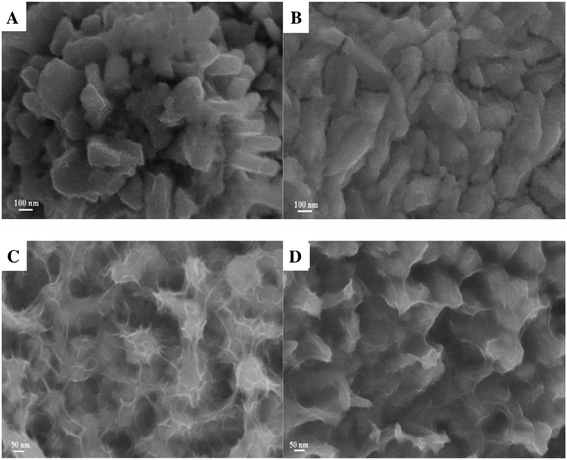 | ||
Fig. 2 SEM images of MoSe2–graphene/Ni with various MoSe2/graphene mass ratios: (A) 5![[thin space (1/6-em)]](https://www.rsc.org/images/entities/char_2009.gif) : :![[thin space (1/6-em)]](https://www.rsc.org/images/entities/char_2009.gif) 1; (B) 6 1; (B) 6![[thin space (1/6-em)]](https://www.rsc.org/images/entities/char_2009.gif) : :![[thin space (1/6-em)]](https://www.rsc.org/images/entities/char_2009.gif) 1; (C) 7 1; (C) 7![[thin space (1/6-em)]](https://www.rsc.org/images/entities/char_2009.gif) : :![[thin space (1/6-em)]](https://www.rsc.org/images/entities/char_2009.gif) 1 and (D) 8 1 and (D) 8![[thin space (1/6-em)]](https://www.rsc.org/images/entities/char_2009.gif) : :![[thin space (1/6-em)]](https://www.rsc.org/images/entities/char_2009.gif) 1. Reproduced with permission.81 Copyright 2015, Elsevier Ltd. 1. Reproduced with permission.81 Copyright 2015, Elsevier Ltd. | ||
 | ||
| Fig. 3 (a) XRD pattern of CoSe2 products. (b) SEM image of the Co3O4 nanowire array on carbon cloth. (c and d) SEM images of CoSe2 on carbon cloth. (e) TEM image of CoSe2 products. (f) HRTEM image of CoSe2. Reproduced with permission.88 Copyright 2015, The Royal Society of Chemistry. | ||
2.2. Batteries
2D-TMDS nanomaterials, including multi-layered nanosheets of layered compounds have been widely investigated and employed in energy storage applications.94,95 Their particular mechanical, optical, and electrical properties are closely bound up with their physico-chemical uniqueness. The TMDS compounds possess a structure similar to graphite, consisting of three atom layers in which the layers of metal atoms are sandwiched between two chalcogen layers. Therefore, Li-ions and Na-ions are easily intercalated and deintercalated from this layered structure because of the weak van der Waals forces. Thus, layered TMDS compounds have been considered as promising anodes for lithium and sodium storage.96Layer structured TMDS are of great interest in energy storage because their crystal structure can be easily utilized for the reversible storage of lithium via electrochemical intercalation, making them good candidates for LIB applications. Recently, a great amount of research has focused on the synthesis and application of various nanostructured TMDS materials in electrochemical lithium storage due to the high theoretical capacity and excellent cycling performance. Many works related to the use of flexible TMDS nanostructure composites in LIBs can be found in the literature. As early as 2006, Xue et al.101 successfully synthesized NiSe2 thin film by reactive pulsed laser deposition and investigated its electrochemistry with lithium for the first time. The reversible discharge capacities of NiSe2/Li cells cycled between 1.0 V and 3.0 V were found in the range of 314.9–467.5 mA h g−1 during the first 200 cycles. Galvanostatic cycling measurements and cyclic voltammetry (CV) were used to examine the electrochemical behavior of the NiSe2/Li cell. A large reversible discharge capacity of 351.4 mA h g−1 of the NiSe2/Li cell was achieved. By using ex situ XRD, TEM and SAED measurements, a complicated electrochemical reaction mechanism of NiSe2 with lithium consisting of three reversible conversions with the intermediates β-NiSe and Ni3Se2 and metal nickel was first proposed. The two redox active centers of both cation (nickel) and anion (selenium) in NiSe2 were revealed. The high reversible capacity and good cycling stability of NiSe2 thin film electrode make it one of the promising storage energy materials for future rechargeable lithium batteries. Shi et al.102 synthesized highly ordered mesoporous crystalline MoSe2 using mesoporous silica SBA-15 as a hard template via a nanocasting strategy (see Fig. 4). Selenium powder and phosphomolybdic acid (H3PMo12O40) were used as Se and Mo sources, respectively. The obtained products had a highly ordered hexagonal mesostructure and a rod-like particle morphology, analogous to the mother template SBA-15. The UV-vis-NIR spectrum of the material showed a strong light absorption throughout the entire visible wavelength region. The direct bandgap was estimated to be 1.37 eV. The high surface area MoSe2 mesostructure showed remarkable photocatalytic activity for the degradation of rhodamine B, a model organic dye, in aqueous solution under visible light irradiation. In addition, the synthesized mesoporous MoSe2 possessed a reversible lithium storage capacity of 630 mA h g−1 for at least 35 cycles without any notable decrease. Wang et al.103 synthesized MoSe2 nanocrystals via a facile thermal-decomposition process. As the anode, the nanocrystalline MoSe2 yielded the initial discharge and charge capacities of 782 and 600 mA h g−1 at a current of 0.1 C in a voltage of 0.1−3 V. Kang et al.104 prepared SnSe nanosheets via a reaction at the oil–water interface in a solvothermal process at low temperature (130 °C), which did not involve any templates and amines such as oleylamine. X-ray diffraction, transmission electron microscopy, absorption spectroscopy and nitrogen adsorption were used to characterize the products. The results indicated that the SnSe nanosheets obtained adopted a square-like morphology with lateral dimensions of approximately 120 nm × 120 nm and possessed high crystallinity. Moreover, their electrochemical performance, as an anode material, was evaluated by galvanostatic discharge–charge tests, showing that the as-prepared SnSe nanosheets exhibited a high initial discharge capacity of 1009 mA h g−1 as a potential energy storage material. Klavetter et al.105 showed the high tap density microparticles of selenium-doped germanium to be a high efficiency, stable cycling anode material in LIBs. In particular, Im et al.106 reported the novel synthesis of GeSex and SnSex (x = 1 and 2) nanocrystals by a gas-phase laser photolysis reaction and their excellent reversible capacity for LIBs. SnSex exhibited higher rate capabilities compared to GeSex. Ex situ X-ray diffraction and Raman spectroscopy revealed the cubic–tetragonal phase conversion of Ge and Sn upon lithiation/delithiation to support their distinctive lithium ion battery capacities. Chen et al.107 synthesized an ordered mesoporous WSe2 with a crystalline framework by a nanocasting method using mesoporous silica SBA-15 as a hard template. The mesoporous WSe2 displayed good electrochemical properties with a high reversible capacity (530 mA h g−1) and stable cycling performance. Another form is TMDS and its nanostructured composite for LIBs. Yao et al.108 synthesized a self-assembled MoSe2 nanolayer/reduced graphene oxide (MoSe2/rGO) foam using a hydrothermal method. The specific capacity of the MoSe2/rGO anode could reach up to 650 mA h g−1 at a current rate of 0.1 C in the voltage range 0.01–3.0 V (vs. Li/Li+), which was higher than the theoretical capacity of MoSe2 (422 mA h g−1). Additionally, the fabricated half cells have shown good rate capability and long cycling stability with 10.9% capacity loss after 600 cycles under a current density of 0.5 C. Ma et al.109 successfully synthesized ultrathin MoSe2/graphene hybrids through a facile ionic liquid-assisted hydrothermal approach. The resultant hybrids were characterized by X-ray diffraction (XRD), field emission scanning electron microscopy (SEM) and high-resolution transmission electron microscopy (HRTEM). It was revealed that the MoSe2 nanosheets in the hybrids exhibited a graphene-like few-layered structural characteristic of 2–3 layers and were well dispersed and anchored on the large flexible graphene sheets. Furthermore, MoSe2@HCNF (hollow carbon nanofiber) composites,110 MoSe2@SWCNT (single-walled carbon nanotube) composites,111 MoSe2@C composites,112 SnSe2@graphene composites,113 SnSe@CNF (carbon matrix) composites,114 SnSe@C composites,115 VSe2/grapheme composites116 and ZnSe/C composites117 were prepared and used for LIBs, exhibiting excellent electrochemical properties.
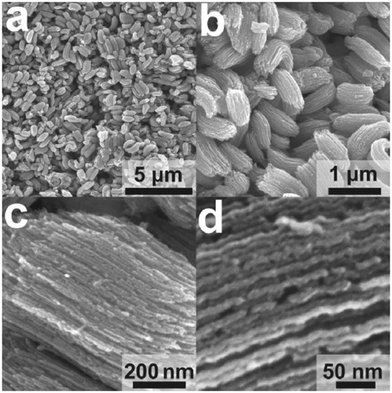 | ||
| Fig. 4 (a–d) SEM images of the synthesized mesoporous MoSe2 materials using SBA-15 as the template via a nanocasting method. Reproduced with permission.102 Copyright 2013, WILEY-VCH Verlag GmbH & Co. KGaA, Weinheim. | ||
In conclusion, it is not easy to replace LIBs with SIBs because the cost per energy stored ($ per W h) of SIBs does not provide much advantage.123 Therefore, new electrode materials having higher reversible capacities are necessary for increasing the energy density of SIBs. Recently, there have been notable achievements in the development of high-capacity 2D-TMDS based materials in SIBs. For example, Ko et al.124 reported pioneering work on the synthesis of yolk–shell-structured MoSe2 microspheres via a simple selenization process, as shown in Fig. 5. The prepared MoSe2 yolk–shell microspheres were aggregates of thin-layered nanosheets and exhibited excellent Na-ion storage properties. The yolk–shell-structured MoSe2 and MoO3 microspheres delivered initial discharge capacities of 527 and 465 mA h g−1 in the voltage range of 0.001–3 V vs. Na/Na+ at a current density of 0.2 A g−1, respectively, and their discharge capacities after 50 cycles were 433 and 141 mA h g−1, respectively. Wang et al.125 synthesized MoSe2 nanoplates for high performance SIBs. Kim et al.126 first examined SnSe as an anode material for SIBs. WSe2 was demonstrated as an efficient electrode for SIBs for the first time by Share et al.127 Recently, much research on energy storage has examined TMDS and its nanostructured composite for SIBs. Zhang et al.128 decorated ultrathin molybdenum diselenide nanosheets on the surface of multi-walled carbon nanotubes (MWCNTs) via a one-step hydrothermal method. The MoSe2@MWCNT composites delivered a reversible specific capacity of 459 mA h g −1 at a current of 200 mA g−1 over 90 cycles, and a specific capacity of 385 mA h g−1 even at a current rate of 2000 mA h g−1, which was better than that of MoSe2 nanosheets. Choi et al.129 exhibited the superior sodium-ion storage properties of MoSe2/CNT (carbon nanotube) composite balls to that of bare MoSe2. Yang et al.130 synthesized porous hollow carbon spheres (PHCS) decorated with MoSe2 nanosheets (MoSe2@ PHCS) via a three-step process. Zhang et al.131 synthesized a flexible MoSe2/CF (carbon fibre) composite by a simple solvothermal method. Zhang et al.132 synthesized SnSe/carbon nanocomposite by high energy ball milling as an anode material for SIBs. Similarly, nanostructured WSe2/carbon composites were synthesized by Zhang et al.133 as anode materials for SIBs.
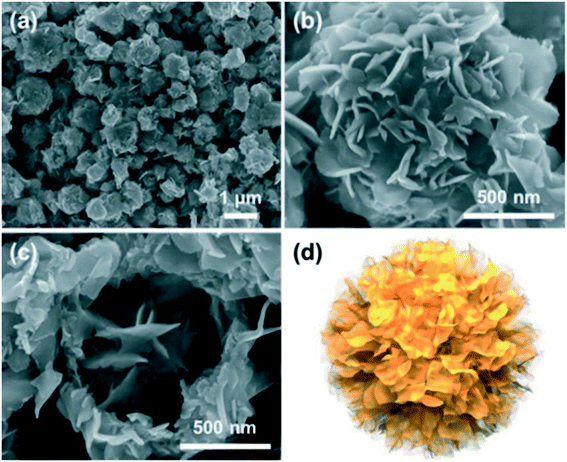 | ||
| Fig. 5 Morphologies of the hierarchical MoSe2 yolk–shell microspheres: (a and b) FE-SEM images, (c) FE-SEM image of the fractured microsphere, and (d) schematic illustration of the microsphere. Reproduced with permission.124 Copyright 2013, The Royal Society of Chemistry. | ||
2.3. Hydrogen storage
Hydrogen, a clean renewable energy source, has been vigorously proposed as the promising future energy carrier in the hydrogen-economy paradigm.134–138 Recently, the generation of hydrogen by efficiently splitting water initiated either by light or by electricity has attracted a great deal of attention due to its cleanliness and low cost.139–146 Hydrogen evolution reaction (HER) is the essential step in water electrolysis where hydrogen is produced by reduction of protons. Both efficient and economical electrocatalysts for HER are required to achieve high current densities at low overpotentials. Although some precious metals and their alloys, such as Pt and Pd, have a exhibited high catalytic activity for HER, the high cost and low natural abundance restrict their practical applications in the industrial production of hydrogen.147Recent studies have proven that newly emerging two-dimensional molybdenum diselenide is a promising noble-metal-free electrocatalyst for HER. Take MoSe2 for example. It is a newly emerging catalyst and most used owing to its low cost, high chemical stability, and excellent electrocatalytic activity.148–152 Similar to the catalytic mechanism of MoS2, the electrocatalytic HER activity of MoSe2 depends strongly on its active selenium edge sites, while its basal planes are catalytically inert.153 Density functional theory calculations reveal that the Gibbs free energy for atomic hydrogen adsorption on MoSe2 edges is closer to thermoneutral than that on MoS2, with an H coverage of about 75% on the edge under operating conditions, which is also higher than that of MoS2 reported in the literature. The consistency between the experimental and computational results indicates that MoSe2 nanosheets have potential to be a better HER catalyst than their MoS2 counterpart. Therefore, reducing the size of MoSe2 down to nanoscale and increasing the exposure of its active edges can boost the catalytic activities of MoSe2. It is reported that the vertically aligned MoSe2 molecular layers on curved and rough surfaces such as Si nanowires and carbon microfibers possess maximally exposed active edge sites and thereby exhibit large exchange current densities in HER.154 In addition to the exposure of active edge sites, electrical conductivity is another key factor influencing the HER performance. However, the poor conductivity between two adjacent van der Waals bonded layers of MoSe2 would significantly suppress their overall HER rate. In this regard, preparation of uniformly distributed MoSe2 nanostructures with more exposed selenium edges on a conductive substrate is an effective strategy to enhance its electrocatalytic performance for HER. For example, Kong et al.155 described a two-step reaction for preparing electrodes composed of CoSe2 nanoparticles grown on carbon fiber paper (see Fig. 6). The electrode exhibited excellent catalytic activity for HER in an acidic electrolyte (100 mA cm−2 at an overpotential of 180 mV). Stability testing through long-term potential cycles and extended electrolysis confirmed the exceptional durability of the catalyst. Zhao et al.156 presented a one-pot colloidal route to synthesize VSe2, a new type of metallic single-layer nanosheet. The about 0.4 nm thick VSe2 single layer nanosheets possessed an extraordinary electrocatalytic HER performance with a low onset overpotential of 108 mV, a small Tafel slope of 88 mV per decade, and an exceptional overpotential of 206 mV at a current density of 10 mA cm−2. In addition, many researchers were fascinated by other TMDSs, such as MoSe2 (ref. 157–175) and WSe2.159,162,170,173–175 Carbon materials, including graphene, CNTs, CNFs, activated carbon, carbon aerogels (CAs), and carbon fiber aerogel (CFA) cloth, etc., are ideal substrates for loading MoSe2 to improve its electrocatalytic activity175–181 owing to the unique physicochemical properties and excellent conductivity of these carbon materials. For example, Huang et al.173 synthesized a unique hierarchical nanostructure of few-layered MoSe2 nanosheets perpendicularly grown on CNTs through a one-step solvothermal reaction. This rationally designed architecture based on a highly conductive CNT substrate possessed fully exposed active edges and open structures for fast ion/electron transfer, thus leading to a remarkable HER activity with a low onset potential of −0.07 V vs. reversible hydrogen electrode, a small Tafel slope of 58 mV per decade and excellent long-cycle stability. Zhang et al.157 reported MoSe2@CFA, which exhibited excellent electrochemical activity as a HER electrocatalyst with a small onset potential of −0.104 V vs. reversible hydrogen electrode and a small Tafel slope of 62 mV per decade, showing its great potential as a next-generation Pt-free electrocatalyst for HER. Tang et al.,72 Liu et al.,165 and Jia et al.182 reported the synthesis of MoSe2@graphene. The number of layers of the MoSe2 nanosheets was typically <10. HER studies showed that the onset potentials of MoSe2 and MoSe2/graphene hybrids were only 0.15 V vs. RHE and 0.05 V vs. RHE, respectively, and about 20–30 mV lower than those of MoS2 and its graphene hybrids. All results indicated that MoSe2@graphene composite film had potential to be a better catalyst for HER. Therefore, due to their high chemical stability, low cost, high-capacity, and excellent electrocatalytic activity, 2D-TMDS materials have become a type of emerging catalyst and have been used extensively in HER.
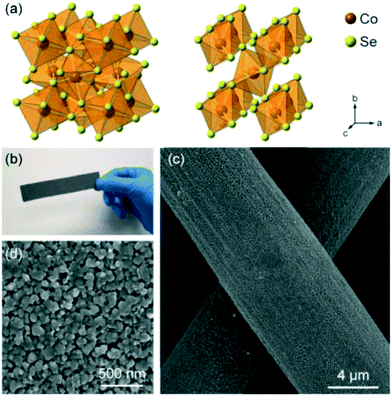 | ||
| Fig. 6 (a) Crystal structure of CoSe2 in cubic pyrite-type phase (left) and orthorhombic marcasite-type phase (right), in which Co and Se are displayed in orange and yellow, respectively. (b) Photograph of as-prepared CoSe2 catalyst on a piece of 1.5 cm × 10 cm carbon fiber paper. (c) SEM image of a layer of CoSe2 catalyst grown on carbon fiber paper. (d) High-resolution SEM image revealing the structure of CoSe2 coating, consisting of nanoparticles in dimensions of tens of nanometers. Reproduced with permission.155 Copyright 2014, American Chemical Society. | ||
3. Summary and outlook
Since the Nobel Prize was awarded for graphene in 2010, there has been considerable research in the field of 2D materials. One particular class of layered 2D materials, TMDCs, is receiving increased interest in applications in energy storage. In recent years, 2D-TMDSs, as a substitute for TMDCs, have attracted more attention in many energy-related applications due to their abundance, chemical and thermal stability, processability and the possibility of tuning their textural and structural characteristics to fulfill the requirements of specific applications. The application of these materials has been extensively researched as energy storage in supercapacitors, LIBs, SIBs, and hydrogen stores.2D layer-structured TMDSs have been recognized to have high electrochemical activity, which is due to their unique metallic conductivity, multiple available oxidation states and special geometric structures with weak interlayer van de Waals coupling. Some TMDSs, including MoSe2, CoSe2, and WSe2, are mainly investigated as novel positive electrode materials for supercapacitors in view of their fascinating physicochemical properties. The development of novel electrodes with more energy and power density for supercapacitor applications has been an emerging area of interest during the recent decade. Similarly, Li-ions and Na-ions are easily intercalated and deintercalated from the layered structure because of the weak van der Waals forces. Thus, layered TMDS compounds have been considered as a promising anode for lithium and sodium storage. Synthesizing new 2D layer-structured TMDSs that have suitable and stable crystal structures as well as good electron/ion conductivities to accommodate long term efficient Li/Na-ion intercalation and deintercalation will be of great significance. On the other hand, constructing composites (e.g., 2D layer-structured TMDS and carbon composite) to utilize the synergistic effect of components is another strategy to promote their lithium/sodium storage capability. As a clean and renewable energy source, hydrogen has a far-reaching significance for the sustainable development of environment and energy. Economical and efficient electrocatalysts for HER are the target of scientific research workers. But at the same time, these require high current densities at low overpotentials. Although some precious metals and their alloys have exhibited high catalytic activity for HER, the low natural abundance and high cost set a limit to their practical applications in industrial production of hydrogen. Due to their high chemical stability, low cost, high-capacity, and excellent electrocatalytic activity, 2D-TMDS materials have become a type of emerging catalyst and have been used potentially in HER. Thus, assembling non-precious 2D-TMDS materials or composites with rich active edges and excellent electron/ion transfer paths to obtain catalysts with high HER activity and can be operated in different systems to replace the current precious catalyst will be the future research directions. In a word, further research on 2D-TMDS materials is needed for clear understanding and as an effective measure to apply in energy storage.
Layered TMDS materials have been known and studied for decades, but their properties as atomically thin, 2D forms are a relatively new and exciting area in nanotechnology, with many promising applications in energy storage. The large bandgaps seen in several members of the TMDS family make them attractive channel materials in logic transistors, and the direct bandgaps in several single-layer TMDSs open up many prospects in energy storage. In studying the physics and chemistry of 2D-TMDSs, researchers will be able to draw upon the previous research on the bulk TMDS intercalation chemistry, material processing and characterization, along with techniques for device fabrication and nanoscale characterization developed with graphene and other nanostructured materials. But 2D-TMDSs have many distinctive properties that are not seen in other material systems. When researchers learn more about them, there are sure to be unexpected and exciting applications. In the next few years, progress in this field will require advances in scalable and controllable sample preparation to make large amounts of atomically thin and uniform TMDS layers, either in solution or on substrates. For solution-phase preparation, the challenges include controlling the area and thickness of either exfoliated or chemically grown flakes and finding new methods and chemicals that can efficiently and safely produce these materials in large scale. For solid-state samples, crystal growth methods need to be improved to achieve large areas, large grain sizes, uniformity and control of layer number. Access to high-quality samples will enable more researchers to better understand the physical and chemical properties of TMDS, as well as to pursue a wider variety of applications. The properties and applications of 2D-TDMS materials are a relatively new but exciting and rapidly expanding area of research.
Acknowledgements
This work was supported by the National Natural Science Foundation of China (U1304214, 21475115), the Program for University Innovative Research Team of Henan (15IRTSTHN001), the Henan Provincial Science and Technology Innovation Team (C20150026), the Nanhu Scholars Program of XYNU and Science and Technology Major Project of Henan province (141100310600), the Key Scientific Research Projects of Henan Province (15B150013), and Xinyang University School Youth Science Projects (2014qn28).References
- M. Sun, H. J. Liu, J. H. Qu and J. H. Li, Adv. Energy Mater., 2016, 6, 1600087–1600120 CrossRef
.
- T. Lu, S. Dong, C. Zhang, L. Zhang and G. Cui, Coord. Chem. Rev., 2017, 332, 75–99 CrossRef CAS
.
- G. Zhang, H. J. Liu, J. H. Qu and J. H. Li, Energy Environ. Sci., 2016, 9, 1190–1209 CAS
.
- M. Chhowalla, H. S. Shin, G. Eda, L. J. Li, K. P. Loh and H. Zhang, Nat. Chem., 2013, 5, 263–275 CrossRef PubMed
.
- H. Schmidt, S. F. Wang, L. Q. Chu, M. L. Toh, R. Kumar, W. J. Zhao, A. H. Neto, J. Martin, S. Adam, B. Özyilmaz and G. Eda, Nano Lett., 2014, 14, 1909–1913 CrossRef CAS PubMed
.
- B. Radisavljevic, A. Radenovic, J. Brivio, V. Giacometti and A. Kis, Nat. Nanotechnol., 2011, 6, 147–150 CrossRef CAS PubMed
.
- H. Wang, H. B. Feng and J. H. Li, Small, 2014, 11, 2165–2181 CrossRef PubMed
.
- J. Xiao, D. Choi, L. Cosimbescu, P. Koech, J. Liu and J. P. Lemmon, Chem. Mater., 2010, 22, 4522–4524 CrossRef CAS
.
- U. K. Sen and S. Mitra, ACS Appl. Mater. Interfaces, 2013, 5, 1240–1247 CAS
.
- H. Hwang, H. Kim and J. Cho, Nano Lett., 2011, 11, 4826–4830 CrossRef CAS PubMed
.
- X. Wang, Z. Zhang, Y. Chen, Y. Qu, Y. Lai and J. Li, J. Alloys Compd., 2014, 600, 84–90 CrossRef CAS
.
- H. Yu, C. Zhu, K. Zhang, Y. Chen, C. Li, P. Gao, P. Yang and Q. Ouyang, J. Mater. Chem. A, 2014, 2, 4551–4557 CAS
.
- X. Y. Yu, H. Hu, Y. Wang, H. Chen and X. W. Lou, Angew. Chem., Int. Ed., 2015, 54, 7395–7398 CrossRef CAS PubMed
.
- L. Yang, S. Wang, J. Mao, J. Deng, Q. Gao, Y. Tang and O. G. Schmidt, Adv. Mater., 2013, 25, 1180–1184 CrossRef CAS PubMed
.
- S. Zhang, X. Yu, H. Yu, Y. Chen, P. Gao, C. Li and C. Zhu, ACS Appl. Mater. Interfaces, 2014, 6, 21880–21885 CAS
.
- H. Yu, C. Ma, B. Ge, Y. Chen, Z. Xu, C. Zhu, C. Li, Q. Ouyang, P. Gao and J. Li, Chemistry, 2013, 19, 5818–5823 CrossRef CAS PubMed
.
- W. Jin, J. Liu, D. Chao, J. Yan, J. Lin and S. Z. Xiang, Adv. Mater., 2014, 26, 7162–7169 CrossRef PubMed
.
- J. Wang, C. Luo, T. Gao, A. Langrock, A. C. Mignerey and C. Wang, Small, 2014, 11, 473–481 CrossRef PubMed
.
- L. Zhang and X. W. Lou, Chemistry, 2014, 20, 5219–5223 CrossRef CAS PubMed
.
- Z. Zhang, S. Pang, H. Xu, Z. Yang, X. Zhang, Z. Liu, X. Wang, X. Zhou, S. Dong and X. Chen, RSC Adv., 2013, 3, 16528–16533 RSC
.
- X. Zhu, Z. Zhen, Y. Wang, Z. Lei, A. Li and F. Huang, Sol. Energy Mater. Sol. Cells, 2012, 101, 57–61 CrossRef CAS
.
- J. Qian, K. J. Jiang, J. H. Huang, Q. S. Liu, L. M. Yang and Y. Song, Angew. Chem., Int. Ed., 2012, 51, 10351–10354 CrossRef CAS PubMed
.
- M. Z. Xue, J. Yao, S. C. Cheng and Z. W. Fu, J. Electrochem. Soc., 2006, 153, A270–A274 CrossRef CAS
.
- Z. Zhang, X. Yang, X. Wang, Q. Li and Z. Zhang, Solid State Ionics, 2014, 260, 101–106 CrossRef CAS
.
- Q. H. Wang, K. Kalantar-Zadeh, A. Kis, J. N. Coleman and M. S. Strano, Nat. Nanotechnol., 2012, 7, 699–712 CrossRef CAS PubMed
.
- C. P. Yang, Y. X. Yin and Y. G. Guo, J. Phys. Chem. Lett., 2015, 6, 256–266 CrossRef CAS PubMed
.
-
CRC Handbook of Chemistry and Physics, ed. D. R. Lide, CRC Press, Boca Raton, FL, 82nd edn, 2001 Search PubMed
.
-
Lange's Handbook of Chemistry, ed. J. G. Speight, 16th edn, McGraw-Hill, New York, 2005 Search PubMed
.
- “Sulfur Statistics” and “Selenium Statistics”. Historical Statistics for Mineral and Material Commodities in the United States, U.S. Geological Survey, Reston, VA, 2014 Search PubMed.
- Material Safety Data Sheet. Acros Organics, ACR20122 (sulfur) and ACR41927 (selenium).
- “Sulfur” and “Selenium”. Mineral Commodity Summaries 2014, U.S. Geological Survey, Reston, VA, 2014 Search PubMed.
- K. V. Kranthi, S. Dhar, T. H. Choudhury, S. A. Shivashankar and S. Raghavan, Nanoscale, 2015, 7, 7802–7810 RSC
.
- Q. Ji, Y. Zhang, Y. Zhang and Z. Liu, Chem. Soc. Rev., 2015, 44, 2587–2602 RSC
.
- Y. Shi, H. Li and L. J. Li, Chem. Soc. Rev., 2015, 44, 2744–2756 RSC
.
- H. F. Liu, S. L. Wong and D. Z. Chi, Chem. Vap. Deposition, 2015, 21, 241–259 CrossRef CAS
.
- K. J. Huang, J. Z. Zhang and Y. Fan, Mater. Lett., 2015, 152, 244–247 CrossRef CAS
.
- Y. Wang, B. Qian, H. Li, L. Liu, L. Chen and H. Jiang, Mater. Lett., 2015, 141, 35–38 CrossRef CAS
.
- K. Share, J. Lewis, L. Oakes, R. E. Carter, A. P. Cohn and C. L. Pint, RSC Adv., 2015, 5, 101262–101267 RSC
.
- Z. Y. Lei, S. J. Xu and P. Y. Wu, Phys. Chem. Chem. Phys., 2015, 18, 70–74 RSC
.
- L. Hao, X. Li and L. Zhi, Adv. Mater., 2013, 25, 3899–3904 CrossRef CAS PubMed
.
- A. L. M. Reddy, S. R. Gowda, M. M. Shaijumon and P. M. Ajayan, Adv. Mater., 2012, 24, 5045–5064 CrossRef CAS PubMed
.
- S. Selvam, B. Balamuralitharan, S. N. Karthick, A. D. Savariraj, K. V. Hemalatha, S. K. Kim and H. J. Kim, J. Mater. Chem. A, 2015, 3, 10225–10232 CAS
.
- P. Humpolicek, V. Kasparkova, P. Saha and J. Stejskal, Synth. Met., 2012, 162, 722–727 CrossRef CAS
.
- G. Wang, L. Zhang and J. Zhang, Chem. Soc. Rev., 2012, 41, 797–828 RSC
.
- Z. S. Wu, G. Zhou, L. C. Yin, W. Ren, F. Li and H. M. Cheng, Nano Energy, 2012, 1, 107–131 CrossRef CAS
.
- M. Beidaghi and Y. Gogotsi, Energy Environ. Sci., 2014, 7, 867–884 CAS
.
- L. L. Zhang, Z. Xiong and X. S. Zhao, ACS Nano, 2010, 4, 7030–7036 CrossRef CAS PubMed
.
- X. Kong, D. N. Lu, Z. Liu and J. Z. Wu, Nano Res., 2015, 8, 931–940 CrossRef CAS
.
- Y. Shao, M. F. El-Kady, L. J. Wang, Q. Zhang, Y. Li, H. Wang, M. F. Mousavi and R. B. Kaner, ChemInform, 2015, 44, 3639–3665 CAS
.
- J. Sun, Z. Li, J. Wang, Z. Wang, L. Niu, P. Gong, X. Liu, H. Wang and S. Yang, J. Alloys Compd., 2013, 581, 217–222 CrossRef CAS
.
- X. Zhang, H. Zhang, C. Li, K. Wang, X. Sun and Y. Ma, RSC Adv., 2014, 4, 45862–45884 RSC
.
- O. Barbieri, M. Hahn, A. Herzog and R. Kötz, Carbon, 2005, 43, 1303–1310 CrossRef CAS
.
- Y. W. Zhu, S. Murali, M. Stoller, K. Ganesh, W. W. Cai, P. Ferreira, A. Pirkle, R. Wallace, K. Cychosz, M. Thommes, D. Su, E. Stach and R. Ruoff, Science, 2011, 332, 1537–1541 CrossRef CAS PubMed
.
- X. Lang, A. Hirata, T. Fujita and M. Chen, Nat. Nanotechnol., 2011, 6, 232–236 CrossRef CAS PubMed
.
- S. C. Hong, S. Kim, W. J. Jang, T. H. Han, J. P. Hong, J. S. Oh, T. Hwang, Y. Lee, J. H. Lee and J. D. Nam, RSC Adv., 2014, 4, 48276–48284 RSC
.
- L. Wang, G. Duan, J. Zhu, S. M. Chen, X. H. Liu and S. Palanisamy, J. Colloid Sci., 2016, 483, 73–83 CrossRef CAS PubMed
.
- S. Faraji and F. N. Ani, J. Power Sources, 2014, 263, 338–360 CrossRef CAS
.
- F. Shi, L. Li, X. L. Wang, C. D. Gu and J. P. Tu, RSC Adv., 2014, 4, 41910–41921 RSC
.
- Q. Yang, Z. Lu, J. Liu, X. Lei, Z. Chang, L. Luo and X. Sun, Prog. Nat. Sci., 2013, 23, 351–366 CrossRef
.
- G. A. Snook, P. Kao and A. S. Best, J. Power Sources, 2011, 196, 1–12 CrossRef CAS
.
- X. Chia, A. Y. Eng, A. Ambrosi, S. M. Tan and M. Pumera, Chem. Rev., 2015, 115, 11941–11966 CrossRef CAS PubMed
.
- J. D. Cain, E. D. Hanson, F. Shi and V. P. Dravid, Curr. Opin. Solid State Mater. Sci., 2016, 51, 141–162 Search PubMed
.
- G. Xiong, P. He, L. Liu, T. Chen and T. S. Fisher, J. Mater. Chem. A, 2015, 3, 22940–22948 CAS
.
- M. Zhi, C. Xiang, J. Li, M. Li and N. Wu, Nanoscale, 2012, 5, 72–88 RSC
.
- S. Z. Butler, S. M. Hollen, L. Cao, Y. Cui, J. A. Gupta, H. R. Gutiérrez, T. F. Heinz, S. S. Hong, J. Huang and A. F. Ismach, ACS Nano, 2013, 7, 2898–2926 CrossRef CAS PubMed
.
- A. Ramadoss, T. Kim, G. S. Kim and J. K. Sang, New J. Chem., 2014, 38, 2379–2385 RSC
.
- H. Wang, H. Yuan, S. S. Hong, Y. Li and Y. Cui, Chem. Soc. Rev., 2015, 46, 2664–2680 RSC
.
- R. Bose, S. K. Balasingam, S. Shin, Z. Jin, D. H. Kwon, Y. Jun and Y. S. Min, Langmuir, 2015, 31, 5220–5227 CrossRef CAS PubMed
.
- Y. N. Ko, S. H. Choi, S. B. Park and Y. C. Kang, Nanoscale, 2014, 6, 10511–10515 RSC
.
- Z. Zhang, Y. Fu, X. Yang, Y. Qu and Z. Zhang, ChemNanoMat, 2015, 1, 409–414 CrossRef CAS
.
- H. Chen, Y. Xie, H. Cui, W. Zhao, X. Zhu, Y. Wang, X. Lü and F. Huang, Chem. Commun., 2014, 50, 4475–4477 RSC
.
- H. Tang, K. Dou, C. C. Kaun, Q. Kuang and S. Yang, J. Mater. Chem. A, 2013, 2, 360–364 Search PubMed
.
- R. Long and O. V. Prezhdo, Nano Lett., 2016, 16, 1996–2003 CrossRef CAS PubMed
.
- A. Arora, K. Nogajewski, M. Molas, M. Koperski and M. Potemski, Nanoscale, 2015, 7, 20769–20775 RSC
.
- K. J. Huang, J. Z. Zhang and Y. Fan, Mater. Lett., 2015, 152, 244–247 CrossRef CAS
.
- Y. Shi, C. Hua, B. Li, X. Fang, C. Yao, Y. Zhang, Y. S. Hu, Z. Wang, L. Chen and D. Zhao, Adv. Funct. Mater., 2013, 23, 1832–1838 CrossRef CAS
.
- X. Cao, Z. Yin and H. Zhang, Energy Environ. Sci., 2014, 7, 18–22 Search PubMed
.
- Y. He, W. Chen, C. Gao, J. Zhou, X. Li and E. Xie, Nanoscale, 2013, 5, 8799–8820 RSC
.
- M. F. El-Kady, S. Veronica, D. Sergey and R. B. Kaner, Science, 2012, 335, 1326–1330 CrossRef CAS PubMed
.
- W. Yuan, J. Chen and G. Shi, Mater. Today, 2014, 17, 77–85 CrossRef CAS
.
- K. J. Huang, J. Z. Zhang and J. L. Cai, Electrochim. Acta, 2015, 180, 770–777 CrossRef CAS
.
- S. K. Balasingam, J. S. Lee and Y. Jun, Dalton Trans., 2015, 44, 15491–15498 RSC
.
- S. K. Balasingam, J. S. Lee and Y. Jun, Dalton Trans., 2016, 45, 9646–9653 RSC
.
- X. Liu, J. Z. Zhang, K. J. Huang and P. Hao, Chem. Eng. J., 2016, 302, 437–445 CrossRef CAS
.
- Z. Wang, Q. Sha, F. Zhang, J. Pu and W. Zhang, CrystEngComm, 2013, 15, 5928–5934 RSC
.
- A. Banerjee, S. Bhatnagar, K. K. Upadhyay, P. Yadav and S. Ogale, ACS Appl. Mater. Interfaces, 2014, 6, 18844–18852 CAS
.
- H. Peng, G. Ma, K. Sun, Z. Zhang, J. Li, X. Zhou and Z. Lei, J. Power Sources, 2015, 297, 351–358 CrossRef CAS
.
- N. Yu, M. Q. Zhu and D. Chen, J. Mater. Chem. A, 2015, 3, 7910–7918 CAS
.
- P. Pazhamalai, K. Krishnamoorthy and J. K. Sang, Int. J. Hydrogen Energy, 2016, 41, 14830–14835 CrossRef CAS
.
- C. Zhang, H. Yin, M. Han, Z. Dai, H. Pang, Y. Zheng, Y. Q. Lan, J. Bao and J. Zhu, ACS Nano, 2014, 8, 3761–3770 CrossRef CAS PubMed
.
- X. Wang, B. Liu, Q. Wang, W. Song, X. Hou, D. Chen, Y. B. Cheng and G. Shen, Adv. Mater., 2013, 25, 1479–1486 CrossRef CAS PubMed
.
- F. Cavallo and M. G. Lagally, Soft Matter, 2009, 6, 439–455 RSC
.
- M. Osada and T. Sasaki, Adv. Mater., 2012, 24, 210–228 CrossRef CAS PubMed
.
- V. Nicolosi, M. Chhowalla, M. G. Kanatzidis, M. S. Strano and J. N. Coleman, Science, 2013, 340, 568–568 CrossRef
.
- Z. Fan, X. Huang, C. Tan and H. Zhang, Chem. Sci., 2014, 46, 95–111 Search PubMed
.
- X. Yang, Z. Zhang, Y. Fu and Q. Li, Nanoscale, 2015, 7, 10198–10203 RSC
.
- Y. Tang, Y. Zhang, W. Li, B. Ma and X. Chen, Chem. Soc. Rev., 2015, 44, 5926–5940 RSC
.
- P. Roy and S. Srivastava, J. Mater. Chem. A, 2015, 3, 2454–2484 CAS
.
- N. Nitta, F. Wu, J. T. Lee and G. Yushin, Mater. Today, 2015, 18, 252–264 CrossRef CAS
.
- L. Zhang, L. Lu, D. Zhang, W. Hu, N. Wang, B. Xu, Y. Li and H. Zeng, Electrochim. Acta, 2016, 209, 423–429 CrossRef CAS
.
- M. Z. Xue and Z. W. Fu, Electrochem. Commun., 2006, 8, 1855–1862 CrossRef CAS
.
- Y. Shi, C. Hua, B. Li, X. Fang, C. Yao, Y. Zhang, Y. S. Hu, Z. Wang, L. Chen and D. Zhao, Adv. Funct. Mater., 2013, 23, 1832–1838 CrossRef CAS
.
- H. Wang, X. Wang, L. Wang, J. Wang, D. Jiang, G. Li, Y. Zhang, H. Zhong and Y. Jiang, J. Phys. Chem. C, 2015, 119, 10197–10205 CAS
.
- S. Z. Kang, X. Li, J. Mu, L. Jia, Y. Yin, L. Li and Y. G. Guo, Colloids Surf., A, 2012, 406, 1–5 CrossRef CAS
.
- K. Klavetter, J. Pedrodesouza, A. Heller and C. B. Mullins, J. Mater. Chem. A, 2015, 3, 5829–5834 CAS
.
- H. S. Im, Y. R. Lim, J. C. Yong, J. Park, E. H. Cha and S. K. Hong, J. Phys. Chem. C, 2014, 118, 21884–21888 CAS
.
- F. Chen, J. Wang, B. Li, C. Yao, H. Bao and Y. Shi, Mater. Lett., 2014, 136, 191–194 CrossRef CAS
.
- J. Yao, B. Liu, S. Ozden, J. Wu, S. Yang, M. T. F. Rodrigues, K. Kalaga, P. Dong, P. Xiao and Y. Zhang, Electrochim. Acta, 2015, 176, 103–111 CrossRef CAS
.
- L. Ma, X. Zhou, L. Xu, X. Xu, L. Zhang and W. Chen, J. Power Sources, 2015, 285, 274–280 CrossRef CAS
.
- Y. Lai, W. Chen, Z. Zhang, Y. Gan, X. Yang and J. Li, RSC Adv., 2016, 6, 19843–19847 RSC
.
- B. Mendoza-Sánchez, J. Coelho, A. Pokle and V. Nicolosi, Electrochim. Acta, 2016, 192, 1–7 CrossRef
.
- Y. Liu, M. Zhu and D. Chen, J. Mater. Chem. A, 2015, 3, 11857–11862 CAS
.
- J. Choi, J. Jin, I. G. Jung, J. M. Kim, H. J. Kim and S. U. Son, Chem. Commun., 2011, 47, 5241–5243 RSC
.
- L. Zhang, L. Lu, D. Zhang, W. Hu, N. Wang, B. Xu, Y. Li and H. Zeng, Electrochim. Acta, 2016, 209, 423–429 CrossRef CAS
.
- Z. Zhang, X. Zhao and J. Li, Electrochim. Acta, 2015, 176, 1296–1301 CrossRef CAS
.
- Y. Wang, B. Qian, H. Li, L. Liu, L. Chen and H. Jiang, Mater. Lett., 2015, 141, 35–38 CrossRef CAS
.
- H. T. Kwon and C. M. Park, J. Power Sources, 2014, 251, 319–324 CrossRef CAS
.
- J. M. Tarascon and M. Armand, Nature, 2001, 414, 359–367 CrossRef CAS PubMed
.
- W. Qin, T. Chen, B. Hu, Z. Sun and L. Pan, Electrochim. Acta, 2015, 173, 193–199 CrossRef CAS
.
- P. Ge and M. Fouletier, Solid State Ionics, 1988, s 28–30, 1172–1175 CrossRef
.
- M. M. Doeff, Y. Ma, S. J. Visco and L. C. Dejonghe, J. Electrochem. Soc., 1993, 140, 169–170 CrossRef
.
- K. Share, J. Lewis, L. Oakes, R. E. Carter, A. P. Cohn and C. L. Pint, RSC Adv., 2015, 5, 101262–101267 RSC
.
- Y. Kim, K. Ha, M. Oh and K. Lee, Chem. – Eur. J., 2014, 20, 11980–11992 CrossRef CAS PubMed
.
- Y. N. Ko, S. H. Choi, S. B. Park and Y. C. Kang, Nanoscale, 2014, 6, 10511–10515 RSC
.
- H. Wang, X. Lan, D. Jiang, Y. Zhang, H. Zhong, Z. Zhang and Y. Jiang, J. Power Sources, 2015, 283, 187–194 CrossRef CAS
.
- Y. Kim, Y. Kim, Y. Park, N. J. Yong, Y. J. Kim, N. S. Choi and K. T. Lee, Chem. Commun., 2014, 46, 50–53 Search PubMed
.
- K. Share, J. Lewis, L. Oakes, R. E. Carter, A. P. Cohn and C. L. Pint, RSC Adv., 2015, 5, 101262–101267 RSC
.
- Z. Zhang, X. Yang, Y. Fu and K. Du, J. Power Sources, 2015, 296, 2–9 CrossRef CAS
.
- S. H. Choi and Y. C. Kang, Nanoscale, 2016, 8, 4209–4216 RSC
.
- X. Yang, Z. Zhang, Y. Fu and Q. Li, Nanoscale, 2015, 7, 10198–10203 RSC
.
- Y. Zhang, Z. Liu, H. Zhao and Y. Du, RSC Adv., 2016, 6, 1440–1444 RSC
.
- Z. Zhang, X. Zhao and J. Li, Electrochim. Acta, 2015, 176, 1296–1301 CrossRef CAS
.
- Z. Zhang, X. Yang and Y. Fu, RSC Adv., 2016, 6, 12726–12729 RSC
.
- C. Wan, Y. N. Regmi and B. M. Leonard, Angew. Chem., Int. Ed., 2014, 53, 6407–6410 CrossRef CAS PubMed
.
- C. Wei, A. M. Asiri, X. Sun, L. Qian, Z. Xing and K. A. Alamry, Appl. Catal., B, 2015, 164, 144–150 CrossRef
.
- X. Peng, Y. Yan, X. Ge, Z. Liu, J. Y. Wang, W. Xin, X. Peng, Y. Yan, X. Ge and Z. Liu, Appl. Catal., B, 2014, s 154–155, 232–237 Search PubMed
.
- T. W. Lin, C. J. Liu and J. Y. Lin, Appl. Catal., B, 2013, 134–135, 75–82 CrossRef CAS
.
- S. Wirth, F. Harnisch, M. Weinmann and U. Schröder, Appl. Catal., B, 2012, 126, 225–230 CrossRef CAS
.
- A. Moya, A. Cherevan, S. Marchesan, P. Gebhardt, M. Prato, D. Eder and J. J. Vilatela, Appl. Catal., B, 2015, 179, 574–582 CrossRef CAS
.
- T. W. Lin, C. J. Liu and C. S. Dai, Appl. Catal., B, 2014, s 154–155, 213–220 CrossRef
.
- Y. Huang, H. Lu, H. Gu, J. Fu, S. Mo, C. Wei, Y. E. Miao and T. Liu, Nanoscale, 2015, 7, 18595–18602 RSC
.
- Y. Shi, C. Hua, B. Li, X. Fang, C. Yao, Y. Zhang, Y. S. Hu, Z. Wang, L. Chen and D. Zhao, Adv. Funct. Mater., 2013, 23, 1832–1838 CrossRef CAS
.
- U. Maitra, U. Gupta, M. De, R. Datta, A. Govindaraj and D. C. N. R. Rao, Angew. Chem., Int. Ed., 2013, 52, 13057–13061 CrossRef CAS PubMed
.
- H. Wang, Z. Lu, D. Kong, J. Sun, T. M. Hymel and Y. Cui, ACS Nano, 2014, 8, 4940–4947 CrossRef CAS PubMed
.
- X. Fan, L. Zhang, W. Min, W. Huang, Y. Zhou, M. Li, R. Cheng and J. Shi, Appl. Catal., B, 2016, 182, 68–73 CrossRef CAS
.
- Q. Liu, J. Tian, W. Cui, P. Jiang, N. Cheng, A. M. Asiri and X. Sun, Angew. Chem., 2014, 126, 6828–6832 CrossRef
.
- P. Jiang, Q. Liu, Y. H. Liang, A. Asiri and X. P. Sun, Angew. Chem., Int. Ed., 2014, 53, 12855–12859 CrossRef CAS PubMed
.
- Y. Huang, Y. Miao, J. Fu, S. Mo, C. Wei and T. Liu, J. Mater. Chem. A, 2015, 3, 16263–16271 CAS
.
- Y. Huang, Y. Miao, J. Fu, S. Mo, C. Wei and T. Liu, J. Mater. Chem. A, 2015, 3, 16263–16271 CAS
.
- X. Hu, Z. Wei, X. Liu, Y. Mei and Y. Huang, Chem. Soc. Rev., 2015, 44, 2376–2404 RSC
.
- J. Shaw, H. L. Zhou, Y. Chen, N. Weiss, Y. Liu, Y. Huang and X. F. Duan, Nano Res., 2014, 7, 511–517 CrossRef CAS
.
- L. Jia, X. Sun, Y. Jiang, S. Yu and C. Wang, Adv. Funct. Mater., 2014, 25, 1814–1820 CrossRef
.
- S. Xu, Z. Lei and P. Wu, J. Mater. Chem. A, 2015, 3, 16337–16347 CAS
.
- Y. Zhang, L. Zuo, L. Zhang, Y. Huang, H. Lu, W. Fan and T. Liu, ACS Appl. Mater. Interfaces, 2016, 11, 7077–7085 Search PubMed
.
- D. Kong, H. Wang, Z. Lu and Y. Cui, J. Am. Chem. Soc., 2014, 136, 4897–4900 CrossRef CAS PubMed
.
- W. Zhao, B. Dong, Z. Guo, G. Su, R. Gao, W. Wang and L. Cao, Chem. Commun., 2016, 52, 9228–9231 RSC
.
- L. Xiao, Z. Li, X. Zang, X. Li and H. Zhu, ACS Appl. Mater. Interfaces, 2016, 8, 10866–10873 Search PubMed
.
- C. Tsai, K. Chan, F. Abildpedersen and J. K. Nørskov, Phys. Chem. Chem. Phys., 2014, 16, 13156–13164 RSC
.
- X. Zhou, J. Jiang, T. Ding, J. Zhang, B. Pan, J. Zuo and Q. Yang, Nanoscale, 2014, 6, 11046–11051 RSC
.
- C. Xu, S. Peng, C. Tan, H. Ang, H. Tan, H. Zhang and Q. Yan, J. Mater. Chem. A, 2014, 2, 5597–5601 CAS
.
- A. Ambrosi, Z. Sofer and M. Pumera, Chem. Commun., 2015, 51, 8450–8453 RSC
.
- Z. Gholamvand, D. Mcateer, C. Backes, N. Mcevoy, A. Harvey, N. C. Berner, D. Hanlon, C. Bradley, I. Godwin and A. Rovetta, Nanoscale, 2016, 8, 5737–5749 RSC
.
- C. H. Mu, H. X. Qi, Y. Q. Song, Z. P. Liu, L. X. Ji, J. G. Deng, Y. B. Liao and F. Scarpa, RSC Adv., 2015, 6, 23–30 RSC
.
- X. Liu, J. Z. Zhang, K. J. Huang and P. Hao, Chem. Eng. J., 2016, 302, 437–445 CrossRef CAS
.
- Z. Liu, N. Li, H. Zhao and Y. Du, J. Mater. Chem. A, 2015, 3, 19706–19710 CAS
.
- R. I. Romanov, V. Y. Fominski, A. V. Shelyakov and G. V. Golubkov, Russ. J. Phys. Chem. B, 2016, 10, 238–244 CrossRef CAS
.
- Y. Liu, L. Ren, Z. Zhang, X. Qi, H. Li and J. Zhong, Sci. Rep., 2016, 6, 1–9 CrossRef PubMed
.
- B. Qu, X. Yu, Y. Chen, C. Zhu, C. Li, Z. Yin and X. Zhang, ACS Appl. Mater. Interfaces, 2015, 7, 14170–14175 CAS
.
- S. H. Lin and J. L. Kuo, Phys. Chem. Chem. Phys., 2015, 17, 29305–29310 RSC
.
- V. Kiran, D. Mukherjee, R. N. Jenjeti and S. Sampath, Nanoscale, 2014, 6, 12856–12863 RSC
.
- U. Gupta, B. S. Naidu, U. Maitra, A. Singh, S. N. Shirodkar, U. V. Waghmare and C. N. R. Rao, APL Mater., 2014, 2, 1167–1178 Search PubMed
.
- Y. Huang, Y. Miao, J. Fu, S. Mo, C. Wei and T. Liu, J. Mater. Chem. A, 2015, 3, 16263–16271 CAS
.
- Y. Huang, H. Lu, H. Gu, J. Fu, S. Mo, C. Wei, Y. E. Miao and T. Liu, Nanoscale, 2015, 7, 18595–18602 RSC
.
- S. N. Grigoriev, V. Y. Fominski, R. I. Romanov, M. A. Volosova and A. V. Shelyakov, Thin Solid Films, 2015, 592, 175–181 CrossRef CAS
.
- X. Zhou, Y. Liu, H. Ju, B. Pan, J. Zhu, T. Ding, C. Wang and Q. Yang, Chem. Mater., 2016, 28, 1838–1846 CrossRef CAS
.
- B. Qu, Q. Ouyang, X. Yu, W. Luo, L. Qi and Y. Chen, Phys. Chem. Chem. Phys., 2015, 17, 6036–6043 RSC
.
- S. Mao, Z. Wen, S. Ci, X. Guo, K. Ostrikov and J. Chen, Small, 2014, 11, 414–419 CrossRef PubMed
.
- D. Xie, W. Tang, Y. Wang, X. Xia, Y. Zhong, D. Zhou, D. Wang, X. Wang and J. Tu, Nano Research, 2016, 9, 1618–1629 CrossRef CAS
.
- W. Gao, Y. Miao, Z. Chao, Y. Zhe, Z. Liu, W. T. Weng and T. Liu, ACS Appl. Mater. Interfaces, 2013, 5, 7584–7591 Search PubMed
.
- S. Rafiei, B. Noroozi, S. Arbab and A. K. Haghi, Chin. J. Polym. Sci., 2014, 32, 449–457 CrossRef CAS
.
- D. Kong, H. Wang, J. J. Cha, M. Pasta, K. J. Koski, J. Yao and Y. Cui, Nano Lett., 2013, 13, 1341–1347 CrossRef CAS PubMed
.
- L. Jia, X. Sun, Y. Jiang, S. Yu and C. Wang, Adv. Funct. Mater., 2014, 25, 1814–1820 CrossRef
.
| This journal is © The Royal Society of Chemistry 2017 |

